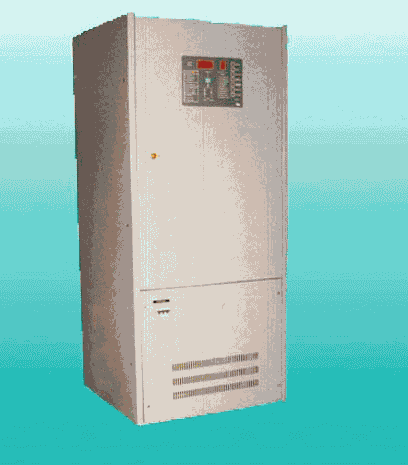
STATIONARY BATTERY CHARGERS
RCB
Series, From 12 To 220 Vcc, Of 10 Amp Up to 400 Amp
FOR ACID OR ALKALINE BATTERIES, OPENED OR SEALED

The
ADI brand battery charger equipments series RCB,
provide voltage with rectified output of CC, for the recharge of a bank of
batteries and a simultaneous supply of a determined consumption,
which requires a safe energy source for its correct operation.
The
charging equipment base their operation on the control phase of the tiristores that compose the rectifying bridge, for
which is necessary to modify the conduction angle of the tiristores..
The instantaneous value of this angle of conduction, is
determined by a system of implemented digital control by means of the
use of a microprocessor.
The use of this technique allows to conceive an equipment of
excellent benefits and discharge reliability for use in the heavy
industry, and where a source of reliable CC is required.
The
digital control system has three proportional
controllers: one for the control of the output voltage, whose value will depend on the type of load curve of
the battery selected, a
second controller for the total output current of the rectifier, and
a third controller for the current to the battery.
In this way, anyone of them can take control from
the rectifying bridge, modifying the voltage or output current,
according to the controller that is operating.
The
output in any of these three controllers is applied in
cascade to one last controller of type proportional + integral
(P + I), whose value of output relates to the conduction angle of
the tiristores.
THE USE OF A SYSTEM OF DIGITAL CONTROL HAS THE FOLLOWING
ADVANTAGES:
- It divides the angle of conduction of
the tiristores in 11000 parts, assuring the
voltage of output in + / - 1 %, due to variations of load of 100 %
- Limits the total current of output and towards the battery in
independent form within the mentioned tolerances. .
- It selects different load curves from batteries, whose
characteristics are stored in the memory of the control
system (EPROM).
- Modifies the
constants of the control system visualizing its value in the display of the front panel
- It modifies the different values from adjustment of the
rectifier (voltage of flotation or bottom, Maximum battery or output current, etc.), with no need to stop the operation,
observinng this in display of the frontal panel.
- Uses digital display to be able to make up to 10
measurements in sequential form such as:
voltage of output, output current,
battery power, time of load, etc.
- Modifies the type of load curve of the battery provided as standard,
by another one according to specification of the manufacturer, only by changing the program (software) of the
control system.
- Makes the remote supervision of one or several equipments,
through a communication port series type RS-232, that allows to send, by means of a modem with some
system of communications (telephony, radio, satellite, etc.),
to a PC, the values of the different measurements that makes the
equipment, the different status from operation and the status of the
alarms.
The ADI charging equipment of series RCB are made as standard
for voltages of monophase feeding of 220 V - 50 Hertz and
triphase of 3 x 380 V - 50 Hertz
The rectifying bridge can be semicontrolled (3 tiristores and
3 diodes), or totally controlled (6 tiristores).
According to the requirements of the consumptions, the
equipment will be able to have different ways of execution:
|
Individual |
A single equipment feeds the consumption and recharges the
battery |
|
|
Parallel |
Stand - By |
Two equipments, one in operation and the other in stand-by
carrying out the same function, at a failure of the first, the second
initiates the supply of the consumption. |
|
|
Parallel with distribution of current |
Connection of several equipments in parallel, from 2 (dual),
to 8 equipments, with distribution of the current in balanced form,
also suppling the consumption and recharging of batteries |
|
|
Average battery type |
Two equipments loading its respective batteries and suppling the
consumptions in parallel without distribution of the current,
recharges the batteries in alternate form |
THE MAIN USES OF ADI CHARGERS ARE:
- Supply of the protection systems of generating
plants and transformer stations of electrical energy
- Supply of the control systems and the reliability of them in plants of
continuous process, such as:
petrochemical petroleum refineries, plants,
compressing gas plants, etc.
- Supply of communications telephone type systems, satelite radio links of microwaves, or communications.